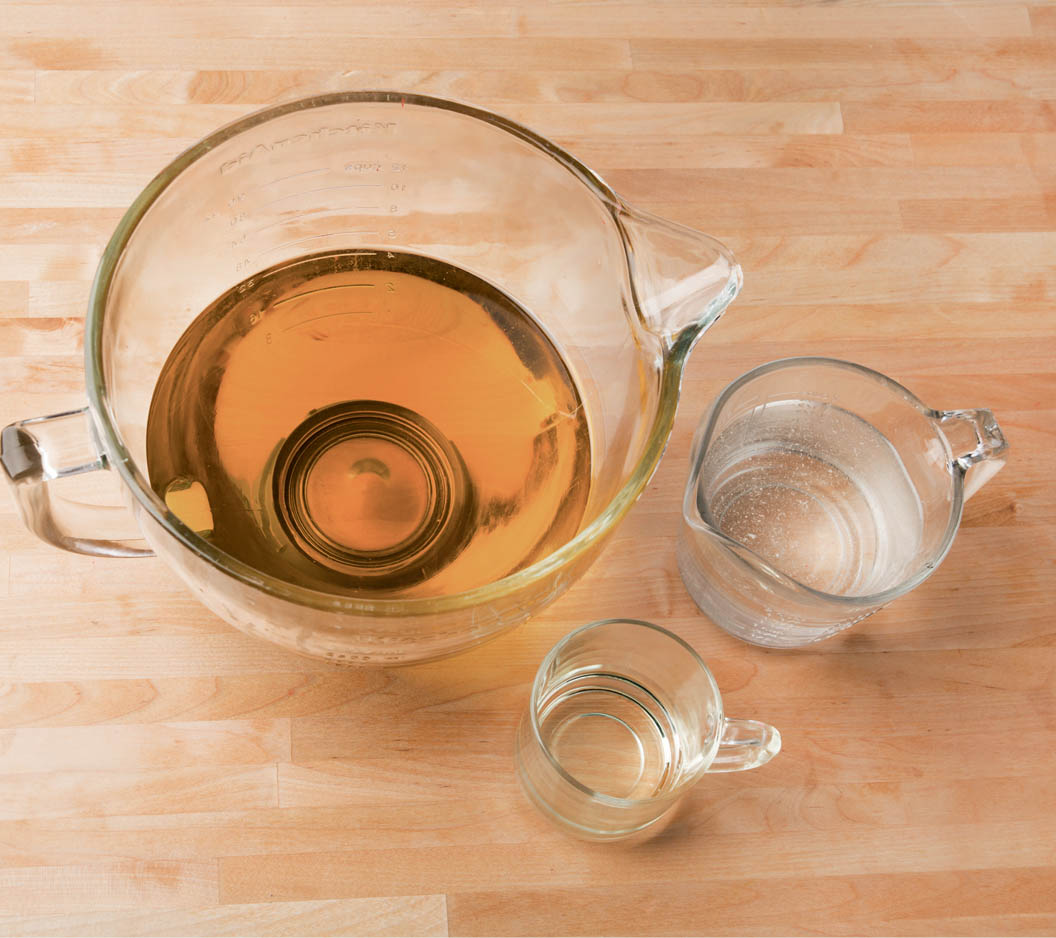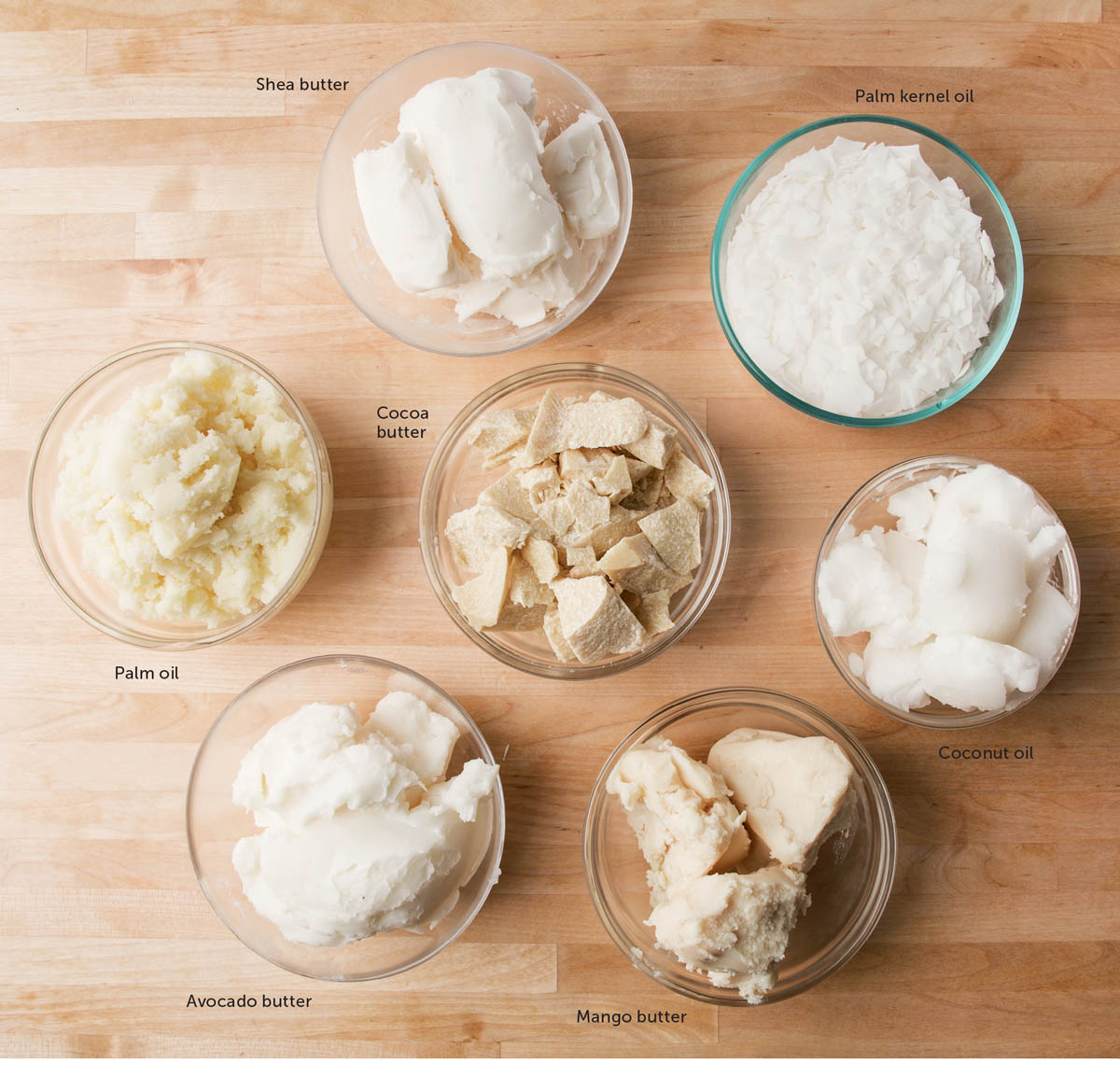
You have many options when selecting oils to use in making soap. The oils you choose will affect the final product with regard to lathering properties, moisturizing ability, bar hardness, and how your skin feels when you get out of the shower.
It generally takes two or more oils to create a well-formulated bar of soap. Many oils are wonderful in combination with others but when used alone don’t create a stellar bar of soap. For example, coconut oil is renowned for its cleansing and lathering properties. But when used at 100 percent, it makes a hard, brittle bar that can leave skin feeling tight and dry. It is best used in conjunction with a conditioning oil such as olive oil.

The Personal Care Products Council maintains a standardized list of scientific names for nearly 20,000 ingredients used in cosmetics — the International Nomenclature of Cosmetic Ingredients (INCI). The United States, members of the European Union, China, Japan, and many other countries all use INCI names when labeling cosmetic products. The entire list, which includes the function of each ingredient (emollient, surfactant, preservative, and so on), is available in CD-ROM or book format; it can also be accessed through the Personal Care Products Council website.
The following list includes a brief description of the oils most commonly used in soapmaking, their INCI names, and the amounts of each oil commonly used in soap recipes. For example, some oils can be used from 10 percent all the way to 100 percent of the total oils in a recipe. The percentage guidelines are just suggestions. Nothing bad will happen if you do not follow the suggested guidelines, though you may end up with a bar of soap that is not well balanced for lather, moisture, and conditioning properties.
Saponification (SAP) values for various oils can vary according to climate, processing methods, and botanical species from which the oil is derived. This potential variation is another reason to work with superfats at a level above 3 percent to ensure a well-formulated, safe bar of soap.


Apricot kernel oil is high in unsaturated fatty acid, which conditions the skin but provides small bubbles. Because of this profile, it is generally not used at more than 15 percent of the total oils in the recipe. At higher percentages it produces a soft bar of soap that does not hold up well in the shower.
Avocado oil is obtained from the pulp of the avocado and used in soap for its moisturizing and conditioning properties. It has a high percentage of fatty acids that do not react with lye to form soap, thus leaving luscious, skin-loving oil in your soap bar. It is rich in vitamins A, B, D, and E. It does not make a hard bar of soap, so is generally used at 20 percent or less in recipes.
Canola oil is a great economical option for soap recipes. Made from a type of rapeseed, it is moisturizing and creates a creamy, stable lather. Some soapers believe it can lead to DOS (Dreaded Orange Spots) in soap, but most soapers prefer it when developing recipes for complicated techniques such as elaborate swirls because it tends to slow the progress of trace, giving the soaper longer to work. Additionally, it produces a whiter soap that allows a wide range of colors to be used without the potential yellowing or greening effects from oils like olive. It can be used up to 35 percent in your recipe.
Castor oil, which is processed from the seeds of the tropical castor-oil plant (Ricinus communis), has a unique fatty acid makeup, being composed almost entirely of ricinoleic acid, a monounsaturated fatty acid. This composition means that even though castor oil is a very thick, viscous oil — a characteristic which typically produces a hard bar — it makes a soft bar of soap when used at more than 10 percent in soap recipes. Use castor oil at 3 to 5 percent to help contribute to a stable, copious lather. Castor oil acts like a humectant and draws moisture to the skin.
Despite its name, cocoa butter is not a butter in the traditional sense — as a solid, it is hard and brittle. It comes from the cacao bean and is a major component of chocolate. It can be purchased in either of two forms: deodorized or natural. In the latter form, it smells like warm cocoa. If you do not want the chocolaty smell to inhibit any light floral fragrances, then you should use the deodorized form. In either form, cocoa butter adds to the moisturizing content of the soap and helps create a hard bar that produces small, stable bubbles. When used at rates of more than 15 percent, it can contribute to cracking.
Coconut oil is obtained from dried coconut meat and is solid at room temperature. Different coconut oils have different melting points (76°F, 96°F, 101°F, and 110°F). All variations are fine to use, though the most popular one is the one with the lowest melting point. You often see the term RBD (refined, bleached, and deodorized) when buying coconut oil, even with an organic product. It’s just a term to explain that the oil has been refined and strained for impurities, bleached for color, and deodorized for a more neutral smell.
Coconut oil contributes to the hardness of the soap. Though it helps produce copious bubbles, the lather is not stable, so coconut oil works best in conjunction with other oils. Because of its high cleansing power, using coconut oil at more than 25 percent of your total oils may make some people’s skin feel dry. It’s generally used at 35 percent or less.
Hazelnut oil provides skin conditioning and a stable, small lather. It has a short shelf life. Because it is low in unsaturated fatty acids, this oil takes longer to trace and is normally used at less than 15 percent of the total oils in recipes.
Though hemp seed oil does not make a stable, long-lasting bar of soap, it does make a luxurious one. Its high level of unsaturated fatty acids gives it great moisturizing abilities, and though it does not contribute to large bubbles, it adds to the conditioning nature of the soap. Hemp seed oil is commonly used at 20 percent or less of the total oils in the recipe.
Jojoba oil — which is derived from the seeds of the jojoba shrub, native to the North American southwest — is actually a liquid wax, not an oil. Because of this, it is incredibly stable and will increase the shelf life of your soap. Jojoba oil adds smoothness to soap, along with stable lather and skin-conditioning properties, but it can weigh down lather if used at more than 10 percent of the total oils in the recipe.
Mango butter is obtained from the seeds of the mango fruit. It is a rich fat that adds excellent conditioning and moisturizing properties to soap. Because it does not contribute much to lather or hardness, it is generally used at 15 percent or less of the total oils in the recipe.
Meadowfoam oil is extracted from the seeds of the meadowfoam plant, a flower native to the Pacific coast of North America. It is a conditioning and moisturizing oil that adds to a creamy lather in soap. It is a good oil for adding a silky, smooth feel to products. It is typically used at 20 percent or less of the total oil in soap recipes.
Olive oil is used in soap primarily for its exceptionally mild and creamy lather. It makes a long-lasting bar that produces tiny bubbles. Any grade of olive oil can be used in soapmaking, but pomace (the final press) is less expensive than extra-virgin olive oil and works just as well. The pomace grade sometimes speeds up trace, so keep that in mind when soaping delicate or intricate designs. Depending on the oil’s color, which can range from a beautiful gold to a thick green, you may have some difficulty achieving a pure white soap if you use large amounts of olive oil in your recipe. Olive oil can be used up to 100 percent; when it is, the result is often referred to as castile soap (paying homage to the region in Spain where 100 percent olive oil soap originated). Castile soap has an incredibly long shelf life, lasting decades if stored well.
Palm kernel oil (which differs from palm oil) is refined from the kernel of the palm fruit, not the pulp. It is sold in the form of solid flakes that must be melted before mixing. It contributes to an exceptionally hard bar and adds a sheen to your soap. Because of their extremely brittle nature and natural tendency to accelerate trace, palm kernel oil flakes should be used at 15 percent or less of the total oils in the soap recipe.
Palm oil is obtained from the pulp from the palm fruit, not the kernel. Its popularity in the food industry has led to concerns about oil palm plantations in West Africa crowding out animal habitats. Palm oil is widely used for its ability to make a hard bar of soap; it also acts as a secondary lathering agent when used in conjunction with coconut oil, helping stabilize the coconut oil’s short-lasting bubbles with smooth, creamy ones. When you use palm oil, it’s important to melt the entire container and stir it thoroughly before measuring the amount called for in the recipe. This ensures that all the different fatty acid chains diffused throughout the oil make it into the soap, preventing the production of bars that are too hard or too soft. Palm oil is generally used at 25 percent or less.
The moisturizing, conditioning oil from the peach kernel adds to the nourishing nature of your soap. It contributes to a stable lather in soap when used in conjunction with coconut oil. It is generally used at 25 percent or less.
Rice bran oil is expressed from the husks of rice grains. It is a light oil that flows smoothly without being sticky. It makes a good addition in soap for its moisturizing and conditioning properties. Rice bran oil produces small, mild bubbles. It is an extremely stable oil, similar to olive oil in shelf life, and can be used up to 100 percent of the oils in your recipe.
Shea butter is obtained from the nut of the African shea tree. It is solid at room temperature and is known for its emollient (i.e., softening) and moisturizing qualities. Because it does not add to the lather or hardness in soap, it is typically used at 10 percent or less of the total oil in recipes.
Soybean oil can be used as a hydrogenated oil (solid at room temperature) or as a liquid oil. While the solid and the liquid have the same saponification (SAP) value, they do have different fatty acid profiles, so the resulting bars will vary according to which type you use. Hydrogenated soybean oil produces a harder bar of soap than the liquid oil. Soybean oil has a creamy, stable lather with good conditioning abilities. It is also inexpensive, making it a popular oil. Soybean oil is typically used at 50 percent or below.
Sunflower oil varies with regard to the amount of linoleic and oleic acid it contains. Different sunflower oils may be labeled, for example, “high linoleic,” “high oleic,” or “mid-oleic.” The fatty acid profiles reflect climatic and genetic differences, but sunflower oil is generally high in unsaturated fatty acids, which leads to a soft bar of soap. All types of sunflower oil are suitable for soapmaking, and all have the same SAP value. Sunflower oil produces a lather that conditions skin but is not entirely stable. It has a short shelf life (up to only 12 months) and does best when used at 20 percent or less of the total oils in the recipe.
Sweet almond oil is a light oil that adds to the conditioning and moisturizing feel of soap. It makes a soft bar and is typically used at 25 percent or less.
Tallow is rendered from the solid fat (commonly called suet) found in cows, sheep, horses, and other animals. You can render your own tallow (though it is a bit of a messy process) or purchase pre-rendered tallow. It provides a stable though small lather and makes a hard bar of soap. Since it is an animal product, if you are making vegan or vegetarian soap, you’ll want to skip using it. Tallow can be used up to 100 percent of the oils in your recipe.
The holy trinity of oils consists of olive, coconut, and palm. If you want to invest in just a few oils to begin with, these are the ones to start with for the best results. While any soap can technically be made with 100 percent of any oil, the only oil I recommend to use up to 100 percent is olive oil. All other oils do best blended with other oils.